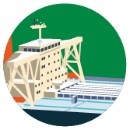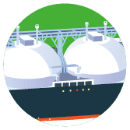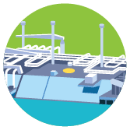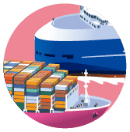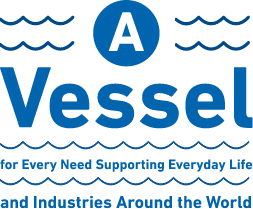
Our vessels play active roles in marine resource development
and offshore energy production.
Some vessels are berthed offshore to produce crude oil and gas.
Some serve as LNG receiving terminals, and more.
This section introduces a wide array of vessels involved in our offshore business.



Broadening the Offshore Business Field
Originally offshore business were focused on floating production, storage and offloading systems (FPSOs) and floating storage and regasification units (FSRUs), which are vessels that operate at a fixed offshore site instead of sailing as a transport vessel.
However, in recent years, many offshore wind farms are being developed far from land, increasing the demand of a variety of vessels for supporting the installation and maintenance of wind turbines and transporting maintenance personnel.
-
![]() Floating production, storage and offloading system (FPSO)
Floating production, storage and offloading system (FPSO) -
Floating Production Storage and Offloading Systems (FPSOs)
FPSO stands for “floating production, storage and offloading system.” Oil reservoir fluids extracted from deep-sea oil fields are brought into an FPSO and separated into crude oil and gas by processing equipment on deck. Treated crude oil is transferred to the cargo tanks in the FPSO’s hull, and regularly offloaded onto shuttle tankers. Treated gas is used as fuel for the FPSO. It is also transported to shore via pipeline or re-injected back into oil wells. This entire series of operations is performed aboard the FPSO. Many FPSOs are converted second-hand oil tankers. The mooring equipment, production equipment, offloading equipment, and so on are installed on the FPSO after hull reinforcement.
![]()
-
![]() Shuttle tankerShuttle Tankers
Shuttle tankerShuttle TankersShuttle tankers transport crude oil from FPSOs or other offshore production facilities to onshore terminals. These tankers are equipped with dynamic positioning systems (which electronically control the ship’s maneuvering to maintain its position), bow loading systems (offshore loading equipment mounted on the bow), and so on to ensure safe loading operation without anchoring, even under severe sea, weather, and tide conditions.
-
![]() Subsea support vesselsSubsea support vessels
Subsea support vesselsSubsea support vesselsSubsea support vessels are used to install, maintain, repair, and remove subsea facilities, playing key roles in every phase of the offshore oil and gas business, including exploration, development, and production.
These vessels feature dynamic positioning systems, remote operated vehicle, deep-sea cranes, and other equipment to implement these operations.
-
![]() Floating storage & regasification unit (FSRU)
Floating storage & regasification unit (FSRU) -
Floating Storage & Regasification Units (FSRUs)
FSRU stands for Floating Storage and Regasification Unit. The main roles of FSRUs are serving as offshore LNG receiving terminals that store LNG discharged from LNG carriers and also re-gasifying it on demand and offloading high-pressure gas to onshore pipelines. Many FSRU projects are in progress around the world, because of lower costs and faster implementation compared to building onshore LNG receiving terminals.
![]()
-
![]() Self-elevating platform (SEP)
Self-elevating platform (SEP) -
Self-Elevating Platforms (SEPs)
Self-Elevating Platforms (SEPs) are vessels that can install wind turbines and foundations for construction of offshore wind farm spread worldwide, mainly in Europe.
SEPs have legs to hoist the hull above seawater, stabilizing the vessel for safe and reliable installation work using the large crane onboard at offshore field.
SEPs also play active roles in supporting projects other than offshore wind farms, such as maintenance of offshore oil/gas wells.![]()
-
![]() Conceptual diagram of the liquefied CO2 carrier
Conceptual diagram of the liquefied CO2 carrier -
Liquefied CO2 Carriers
Liquefied CO2 carriers are a means of efficiently transporting captured and liquefied CO2 to storage or usage sites in the carbon dioxide capture utilization and storage (CCUS) value chain, which is attracting worldwide attention.
Studies are underway on various ship sizes and dual-purpose carriers that can also transport next-generation clean energy, as MOL works to respond flexibly to various transportation needs.![]()


